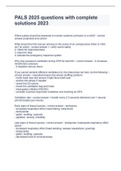What should the first rescuer arriving on the scene of an unresponsive infant or child do? (in order) - correct answer 1. verify scene safety
2. check for responsiveness
3. shout for help
4. activate the emergency response system
Why may excessive ventilation during CPR be harmful? - correct answer - it increases intrathoracic pressure
- it impedes venous return
If you cannot achieve effective ventilation (ie, the chest does not rise), do the following: -
correct answer - reposition/reopen the airway (sniffing position)
- verify mask size and ensure a tight face-mask seal
- suction the airway if needed
- check the O2 source
- check the ventilation bag and mask
- treat gastric inflation (NG/OG)
- consider 2-person bag-mask ventilation and inserting an OPA
Ventilation rate - correct answer 1 breath every 2-3 seconds delivered over 1 second (20-30 breaths per minute)
Early signs of tissue hypoxia - correct answer - tachypnea
- increased respiratory effort (nasal flaring, retractions)
- tachycardia
- pallor, mottling, cyanosis
- agitation, anxiety, irritability
Late signs of tissue hypoxia - correct answer - bradypnea, inadequate respiratory effort, apnea
- increased respiratory effort (head bobbing, seesaw respirations, grunting)
- bradycardia
- pallor, mottling, cyanosis
- decreased level of consciousness What is the role of the diaphragm during normal breathing in infants? - correct answer pulls the ribs slightly inward
S/S mild respiratory distress - correct answer - mild tachypnea
- mild increase in respiratory effort (nasal flaring, retractions)
- abnormal airway sounds (stridor, wheezing, grunting)
S/S Severe respiratory distress - correct answer - marked tachypnea
- marked increase in respiratory effort
- paradoxical throacoabdominal breathing (seesaw breathing)
- accessory muscle use (head bobbing)
- abnormal airway sounds (grunting)
- decreased level of consciousness
S/S Impending respiratory arrest - correct answer - bradypnea, apnea, respiratory pauses
- low oxygen saturation (hypoxemia) despite high-flow supplemental oxygen
- inadequate respiratory effort (shallow respirations)
- decreased level of consciousness (unresponsive)
- bradycardia
What steps should be taken as part of initial management of a child in respiratory distress? - correct answer - monitor O2 sat by pulse ox
- monitor HR, rhythm, and, BP
- support an open airway
Stridor - correct answer high-pitched breathing during inspirations
Crackles - correct answer breath sounds heart during expirations
How should 1-rescuer infant compressions be delivered? - correct answer - two fingers or two thumbs
- rate of 100-120
- single rescuer (30:2)
- two rescuer (15:2)
How should 1-rescurer child compressions be delivered? - correct answer either one or two hands
- compress at least 1/3 the chest diameter (approximately 2 inches)
Guidelines for rescue breathing for infants and children - correct answer - give 1 breath every 2-3 seconds (about 20-30/min)
- given each breath in 1 second
- visible chest rise
- check pulse every 2 minutes
- use oxygen as soon as it is available


